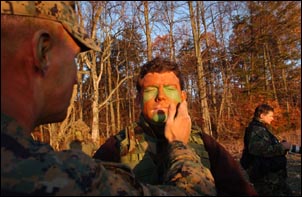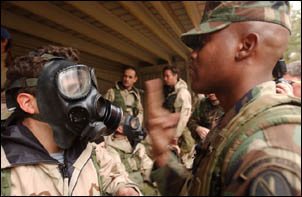|
|
||||
"With pictures of blistered and deformed victims from the Iran/Iraq war on a PowerPoint screen in front of us, we don our cumbersome biological warfare suits in a solemn manner. It was nearly the end of Media Training Course hosted by the Military Services at Quantico Marine Corps base in Quantico, Virginia and aboard the USS IWO JIMA off the coast of Virginia. For one week myself and over 40 members of the national and international media have been exposed to hair raising helicopter rides, arbitrary simulated combat attacks, 5 am pounds on the door and up to six hours of classroom lectures daily. I’d come to the training course in the hope of learning something about war: why we go to it, who fights it and what to do as a photojournalist to cover it both safely and thoroughly. The military has created the course to familiarize reporters covering future conflicts in the fundamentals of the Armed Forces. While they’ve so far refrained from making promises, the military claims that they are committed to ensuring that members of the press will have full access to the front lines on the Global War on Terrorism (GWOT). All in all it was an unforgettable week during which the traditional tension between the media and the military was temporarily shelved as we both learned from each other and hopefully made inroads towards a more mutually beneficial relationship. It’s Saturday November 17 and we are commencing camp with nothing less than a Pentagon briefing from Ms. Victoria Clarke, Assistant Secretary of Defense for Public Affairs. Her comments are cordial but foreboding as she passes around a waiver to be signed that alludes to a walk through a “gas chamber” as part of the course. From Washington we’re flown to the Marine Corps Air Station at Cherry Point North Carolina where buses take us to two Navy LCAC’S, high-speed, over-the-beach amphibious landing crafts, that are awaiting our arrival to take us out to the USS IWO JIMA, four miles out in the Atlantic. The ride on the LCAC proves to be our first introduction to the rigors to be expected if we are to be imbedded with the military in any future conflict with Iraq. While some of the veteran journalists had experienced the unique charms of the LCAC ride in past conflicts, the 4 to 6 foot seas create the sensation of a roller coaster ride in a dark, sweltering box, leaving many a reporter lunging for the sick bags that are strategically placed in our compartment. As we disembark our newly dubbed “LYaks” in the belly of the IWO JIMA, hundreds of sailors witness journalists walking wearily with full sick bags in hand. The 3-day Navy period of our training proves to be informative, if lacking in the kind of training we may need in a future conflict. As far as the Armed Forces go, the Navy looks to be the most hospitable. We’re housed in deluxe rooms with tidy curtained bunk beds, that conjure memories of that first class Berlin- to- Paris sleeper I once took. On the first evening of our stay we witness a mock fire and man overboard drill, which myself and the handful of other still photographers photograph with amusement. The fire drill proves to be the most interesting as we’re taken into a “smoke room” where some of us gear-up with oxygen tanks and masks, learning the basics of fire rescue. A television reporter manages to bang his head on a air tank and is taken to the infirmary for an ice bag. The next segment of our course is with the U.S. Marines at Quantico. We spend the first evening at the base being issued individual gear, which includes everything but an M-16 rifle. We ‘re told that all journalists will be expected to wear the camouflage pants, jackets, flack jackets, backpacks and helmets for the duration of our stay. Quantico, an architecturally sterile series of buildings that sits on over 200 acres of woodland, is the part of the camp that most of us are anticipating. The topics to be discussed confront situations such as landmines, chemical attacks, and combat first aide, situations that today’s journalist is increasingly likely to encounter. Preparing to go to bed on our first evening at the base we hear the occasional blasts of artillery in the distance. We quickly learn that the training never pauses at Quantico, and while it’s never admitted that training has been heightened since 9/11, I can’t help to feel that the intensity I’m witnessing is partly due to a man named Saddam.
Our first morning at Quantico is
The highlight of the course comes in the form of a simulated ground attack after a helicopter landing. We are marched out to a field before sunrise and shown how to apply camo paint to our faces. Quickly forgetting the embarrassing gun photo the day before, the situation gets out of hand as dozens of journalists begin smearing their faces with layers of brown, black and green make-up. Before long we resemble a group of extras in the Kurtz compound scene in Apocalypse Now. As the sun rises over Quantico, two Marine piloted helicopters arrive to ferry us out to a site in the woods where we will be camping for the night. Before departing we are given a quick lesson in exiting and entering a “bird” under fire. In our respective platoons, we practice running and diving on our stomachs. After a 15 minute helicopter ride that can only be described as intense, we land in an open field that has come under “enemy” fire. With my backpack, camera gear and bedroll I scramble out of the helicopter with my colleagues amidst smoke grenades and the sound of gunfire. My platoon leader screams at us to get down. Peeking my head up to get a few pictures, I can’t help but to admire the effort the Marines have gone through to make this a true to life (and somewhat unsettling) experience. Within an hour we are back to safety eating MRE’s (Meals Ready To Eat) and trading war stories. With every reporter who decides to cover conflict there inevitably comes a time when they question the reasoning that went into that choice. During the Media Training Course that time surely came for many of us during the NBC (Nuclear Biological Chemical) training. With the artillery and landmine exercises we had done up to now, at least we understood the weapons of our potential foes and how to conduct ourselves in a manner that will enhance our chances for survival. In the case of a mustard gas attack, a nasty and often slow death, all previous war zone logic is turned on its head. Usually one can’t hear, see or even feel a gas attack until deadly symptoms have set in. While this is not always the case, and we are taught what signs to look for if weapons of mass destruction have been deployed, it is still an unsettling thought as we head into the hypothetical war zone of the future where a biological warfare suit is the new flack jacket.
We spend most our last full day involved in a NBC training
class where each of us is fitted with a protective suit, gas mask, boots
and gloves. After some time trying to get into the cumbersome attire
we’re told that in the case of a real NBC emergency we would have
no more than 9 seconds to get into our gear before the substance began
to take effect. This works to quicken our determination to learn the
procedure and quells any complaints over ill-fitting boots and gloves.
After the farewell lecture and class photo on the lawn, it was evident that despite some minor spats, both the military and the press made great headway during the weeklong course. While the line of journalistic objectivity is still clearly marked, both parties see that in this new war on global terrorism we each have much to gain from each others experience. Firstly, the military is gaining respect for a press core to often viewed as an antagonistic voice that can’t be trusted (there were numerous former marines attending the media course, one who had received two purple hearts in combat). The press, especially those that haven’t previously covered the military, is learning that the Armed Forces are a unique culture unto them selves that at the very least warrants respect and
understanding. We must not forget the larger picture that is at hand
in the post 9/11 world. For the fist time in half a century, modern
civilization is being challenges by a belief system that condones suicide
bombings, biological and chemical weapons and the killing of non-combatants
to achieve political gains. This by no means implies that the media
needs to practice self-censorship in the covering of military affairs.
But, as the tragic case of Daniel Pearl made so clear, we are all acceptable
targets now. |
||||||
|
|
Write a Letter
to the Editor |



